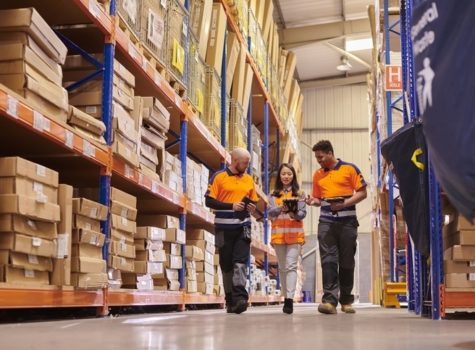I always thought my high school basketball coach had a one-track mind. I can still hear her drilling into us the importance of the triple threat. Little did I know that years later, that triple threat mindset would come into play with warehouse technology.
In basketball, when you receive the ball with your feet firmly planted ready to shoot, pass, or drive, you’re keeping your options open. Your opponent has to be ready for anything as you put yourself in a position that allows you to make a play on the situation.
You have a shot? You take it. See a player with an open shot? You dish it to them. You see an open lane? Take it to the hoop. It’s all about versatility, control, and readiness. In the triple threat position, you’re dangerous from all angles.
Modern warehouse technology needs that same kind of versatility. To stay competitive, fulfillment teams need to be ready for anything. The warehouse triple threat of automation, load planning, and real-time analytics gives your operations the flexibility, precision, and insight it takes to win in today’s shipping environment.
Why one tool isn’t enough
It’s tempting to throw one tool at a warehouse problem and call it good. But in reality, each solution only handles a slice of the bigger picture. And when they aren’t integrated, things slip all too fast.
Automation alone isn’t enough: Shipping automation is incredible for speed, and it’s absolutely necessary for the modern warehouse to handle large volumes of shipments. But it doesn’t know whether you’ve chosen the right box—or whether that box fits on the truck. It can label a package in milliseconds, sure. But it can’t prevent you from overpacking or underutilizing your trailer space.
Planning alone isn’t enough: Load planning tools shine when it comes to packing efficiency. They will save you money when it comes to both shipping costs and packing material. But without real-time data from your WMS or shipping engine, they’re flying blind. Orders change. Inventory shifts. Your plans have to flex with the flow of operations.
Analytics alone isn’t enough: Data dashboards are great at pointing out problems. Without data, and the all-important interpretation of the data, you’ll never meet your full potential. But data alone won’t fix your issues. You might discover your on-time delivery rate dropped last week, but without automation and planning systems in place, all you can do is shrug and watch it happen again.
A future-ready warehouse isn’t about having a tool. It’s about combining the right tools—and making sure they work as a team.
The case for a fully integrated fulfillment stack
The best warehouses don’t treat shipping, planning, and analytics as siloed systems. They stitch them together into a smart, responsive ecosystem—one that reacts in real time, scales with demand, and gets smarter with every order.
When that happens, fulfillment transcends being fast to become fluent.
Automation feeds real-time data into planning. Planning adjusts on the fly. Analytics loops back with insight, sharpening the next move. It’s a closed loop that runs like a well-oiled machine—or better yet, like a basketball team that’s completely in sync, reading each other’s moves and executing with precision.
It’s not about stacking tools on top of each other. It’s about building a single engine that runs your warehouse with the intelligence and flexibility of a team that knows how to win.
Automate, optimize, analyze
Each piece of the triple threat plays its role, but they’re most powerful when they’re passing to each other in stride.
Automation: Speed meets simplicity
With EasyPost Enterprise, label generation, rate shopping, customs documentation, and tracking updates happen automatically. No manual clicks. No decision fatigue. Just fast, accurate shipping at scale. And because it plugs directly into your WMS, OMS, and carrier network, it plays nice with everything else on the court.
Load planning: Efficiency in every load
MagicLogic makes the most of every inch, whether you’re packing boxes, pallets, or trailers. It chooses the best carton, stacks with robotic precision, and keeps your packaging lean and mean. The bonus: fewer damages, lower DIM charges, and a lot less filler material clogging up your budget.
Analytics: Intelligence that drives action
EasyPost Analytics connects the dots from label to delivery and back again. It’s your always-on scout, spotting trends, bottlenecks, and outliers before they become headaches.
Want to know which carrier is dragging you down? Or which warehouse team is crushing it? You’ll have the answer, along with the data to back it up.
A unified approach to warehouse modernization
When automation, planning, and analytics work together, your warehouse transforms from reactive to proactive. Problems are addressed before they snowball. Shipments flow without hiccups. Data isn’t just collected, it’s acted on.
Take this example: An order comes in. Automation selects the optimal carrier and prints the label. Planning software determines the best box and the most efficient way to stack it. Analytics sees a spike in returns for a specific product and alerts your team to investigate. All of it happens behind the scenes. All of it is connected.
If the system needs to adapt? No problem. The same tools that fulfill orders today are already learning how to do it better tomorrow.
Just like with a great team, the magic lies in the connection. True integration isn’t about clunky data exports or nightly syncs. It’s built on real-time APIs, shared data models, and business rules that flex with your workflows. Whether you’re cloud-based or running on-prem, everything works together as a cohesive unit.
It’s like running a full-court press with no weak link. Everything’s in sync, everything’s responsive, and everything’s fast.
Ready to level up?
Warehouse modernization doesn’t require reinventing everything. You just need the right triple threat.
Want to learn how to implement all three solutions in your operations? Check out the ebook: The Warehouse of the Future: Smarter, Faster, More Efficient.


